People have been using electricity for a long time and almost never wonder whether the current in the outlet is AC or DC. The answer is quite simple, since 98% of all electricity produced is AC. This advantage is due to the ease of production and the possibility of transfer to long distances compared to direct current. During transmission, the value alternating current may increase or decrease repeatedly. Thus, most sockets work with alternating current. But, there are many consumers from the field of electronics, operating on direct current, with a voltage of 6 to 12 volts.
D.C
The concept of electric current is the ordered movement of charged particles, which are affected by forces electric field or other outside forces. The direction of current is the direction in which positively charged particles move.
If the value of the strength of the electric current and its direction remain unchanged, this current is considered constant. For its existence, free charged particles are necessary, as well as a current source that converts energy into the energy of an electric field. Under the action of outside forces, charged particles move. Their occurrence is due to various reasons. For example, for batteries and galvanic cells, these will be chemical reactions. Generators generate current using a conductor moving in a magnetic field. In solar cells, light acts on the electrons of semiconductors and metals.
Direct current is used in industry, making it easier to start equipment with a large starting torque. DC motors are used for stepless speed control, they greatly smoothen Starting torque. Direct current is generated by accumulators and batteries. Its value can range from 6 to 24 volts.
Alternating current
Unlike direct current, alternating current has the ability to change in direction and magnitude at regular intervals. It is being developed. in which the occurrence electromotive force occurs under the influence of electromagnetic induction.
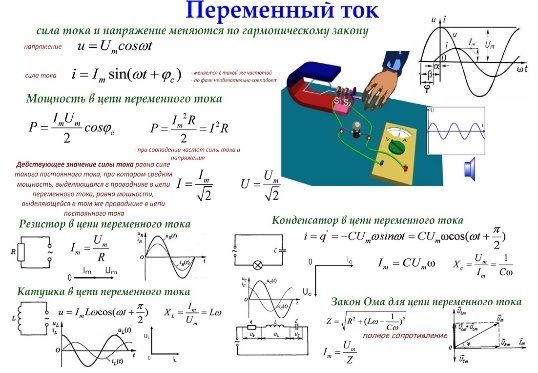
Alternating current is widely used in various fields, due to the ability to convert its strength and voltage with minimal energy loss. It can be single phase or three phase. In the latter case, the electrical system includes three circuits with the same frequency and EMF, shifted from each other in phase by 120 degrees.
With the help of alternating current, the transmission of electrical energy over long distances became possible. During wired transmission, certain losses occur in an amount proportional to the square of the current. To reduce losses, voltage reduction is necessary. The reduced current necessitates a significant increase in voltage. Therefore, electricity is transmitted over long distances only if there is high voltage. The conversion of currents to the required parameters is carried out using transformers, which are electromagnetic devices of a step-down or step-up type.
Types and parameters of sockets
Electrical outlets are fairly simple devices. Nevertheless, they have important functions, first of all, they provide reliable contact between household appliances and the mains. Sockets reliably protect against touching current-carrying parts, provide reliable insulation. Most modern socket models have a function protective earth performed by a separate contact.
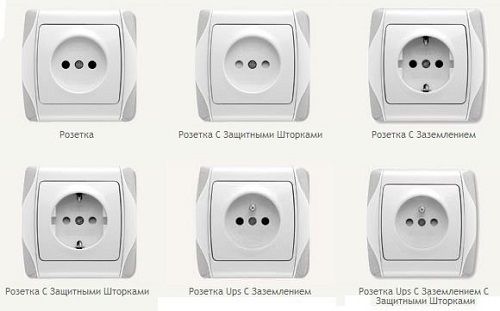
All electrical outlets are divided into several types. In accordance with the fastening used, they can be open or hidden. For example, outdoor wiring requires overhead sockets open type. They are easy to install and do not require holes for sockets. Built-in socket models are attractive appearance, reliable fastening and a high degree of protection against electric shock due to the location of current-carrying parts deep in the wall.
Sockets differ among themselves and in the magnitude of the current. Most modern outlets are rated for 6, 10 and 16 amps. The maximum current of the old Soviet models was only 6.3 amperes. Consumers with increased power are connected to special sockets with high resistance to high currents. As a rule, this is stationary equipment. Maximum admissible current sockets must correspond to the power of the consumer connected to the electrical network.
How to measure AC voltage at an outlet
There is a lot of information on the Internet and various other sources on how to learn how to use a multimeter, how to measure voltage, current, resistance. Everyone shows, tells, but novice masters continue to make mistakes when taking measurements. These errors are costly - measuring instruments fail, sometimes the devices in which measurements are taken burn out, or even worse, people get electric shocks and other injuries. The purpose of this article is to show and clearly explain why certain things cannot be done when taking measurements using specific examples. A person should not remember why not, but understand how it should be and why not otherwise.
Let's start with the goals for which they are carried out measurements.
It is impossible to visually, by external examination, determine the modes of operation of the elements of an electrical circuit or circuit.
For this measuring instruments carry out measurements, i.e. determine whether there is an overload of individual elements, whether the supply voltages correspond to the norm, etc.
And now the main thing is that the measuring device should not affect the circuit when it is connected to it, otherwise the measured values \u200b\u200bwill not correspond to the values that they actually have. In other words, the state of the circuit without a meter connected must remain the same after the meter is connected.
How it is implemented in different modes:
- Voltage measurement. Voltage is the potential difference between two points. For example, there are two points A and B.
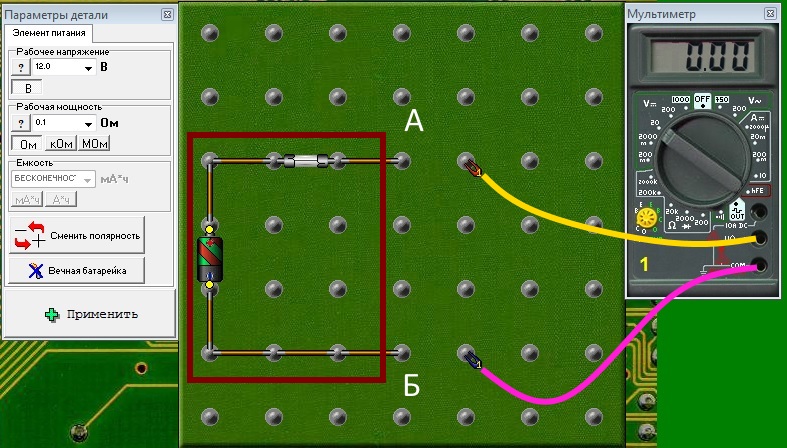
Their potentials are different, therefore, there is a voltage between them. We need to measure it. To measure it, you need to connect a voltmeter to these points. Voltmeter should not change the state of points A and B when connected. This is possible if the voltmeter will have an infinitely large resistance (in reality it is tens or even hundreds of megaohms) and when it is connected to points A and B there will be practically no current, otherwise the presence of current will affect the magnitude of the potentials of the points. The higher the class of the voltmeter, the higher its internal resistance and less impact on the circuit when making measurements.
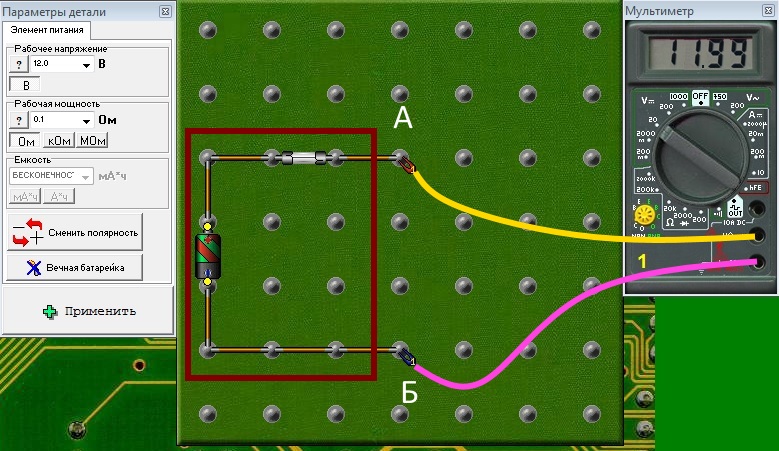
Conclusion–voltmeter has an infinitely large internal resistance, is connected to the measured points in parallel, with the power on. Before the measurement, you must select the mode - direct voltage or alternating voltage, set the limit above the expected measurement result and take the measurement.
- Current measurement. Electricity is the directed movement of electrons. For the current to flow between points A and B, two conditions must be met: the presence of a potential difference (voltage) between points A and B and the presence of an electrical circuit connecting these points. The magnitude of the current will be determined by the magnitude of the voltage between points A and B and the magnitude of the resistance of the electrical circuit. This is Ohm's law I=U/R. The picture below electrical circuit is a light bulb, its characteristics are a voltage of 12 V and a current of 5 A.
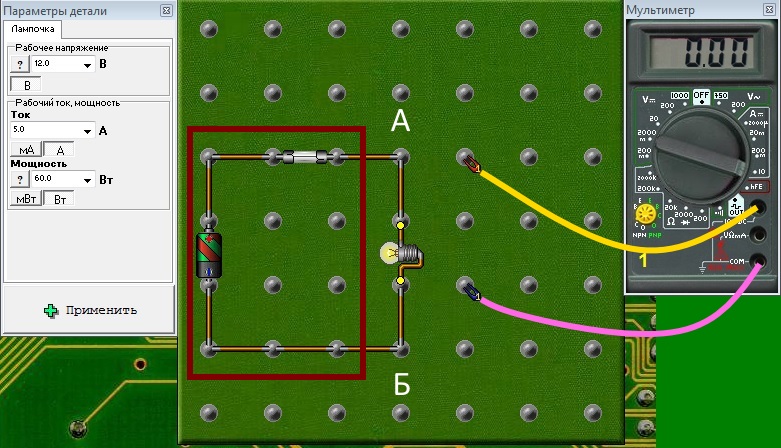
To measure current ammeter must be included in the circuit. To do this, you need to break it and let the light bulb current through ammeter. According to the principle of minimal influence on the electrical circuit, it is clear that the resistance of the ammeter should be minimal. The real resistance of a good ammeter is a fraction of an ohm, sometimes even thousandths. In fact, we will replace a piece of wire with an ammeter.
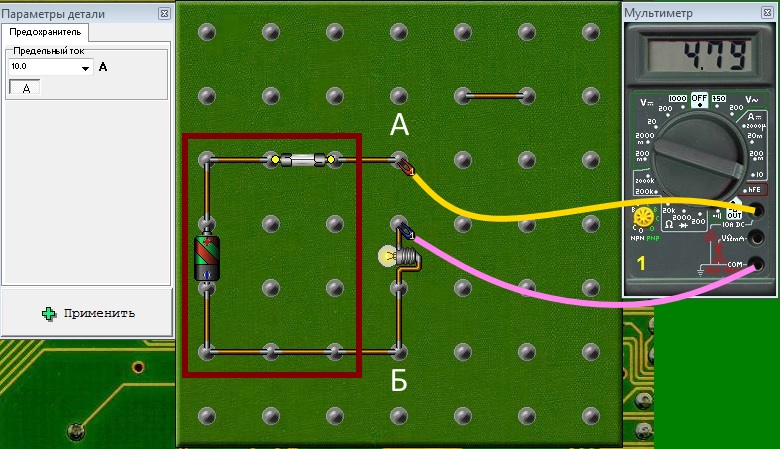
Conclusion– ammeter has an infinitely small internal resistance, is connected to break the existing electrical circuit, with the power off. Before measuring, you must select the mode - D.C. or variable, set the limit above the expected measurement result, turn on the power and take a measurement.
And now the most important thing. There is an outlet, it has two points, let's call them the same, A and B. The outlet says ̴ 6 A, 220 V.
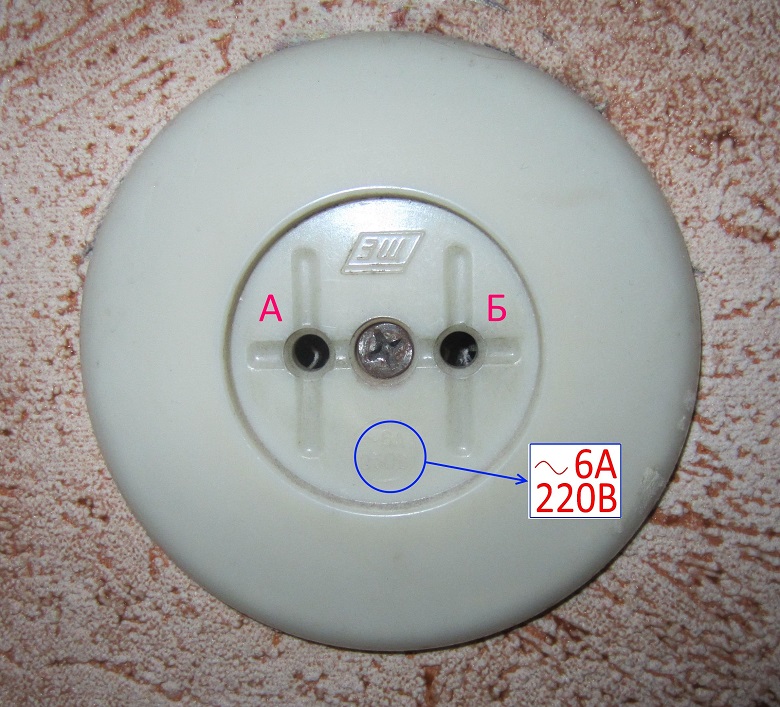
Some novice masters, seeing this, think, well, let me check my purchased device.
He sees the inscription ̴ 220 V. He sets the measurement mode AC voltage, the limit sets more than this value, for example, 750 V, and the probes into the socket, sees the measurement result of 220 V. Everything is correct here. This is similar to our voltage measurement example at the beginning of this article.
And now I measure the current, will it show me these 6 A, as indicated on the outlet. 6 A is written on the outlet, sets the device limit to 10 A and the probes into the outlet !!! There is no spark, bakhi and device !!! You'll be lucky if the plugs work. How many devices burned out from such measurements. Here's how it looks when simulating the situation in the program "Beginnings of Electronics":
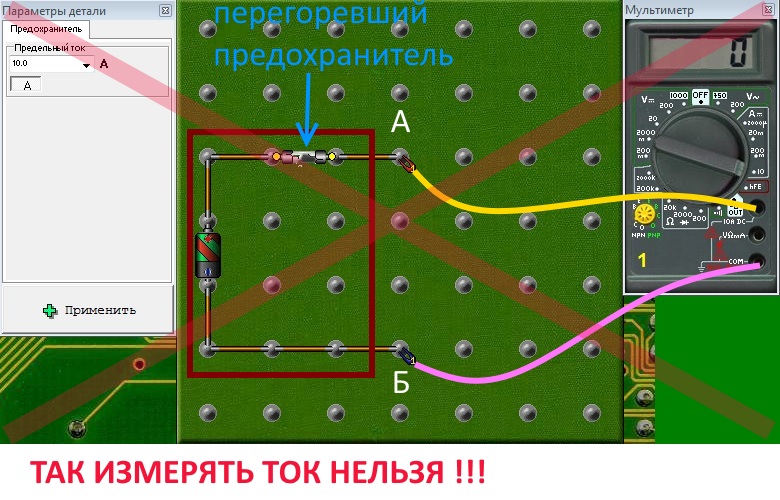
Let's take a closer look at why, so as not to remember that this is not possible, but to understand.
For the flow of electric current, as mentioned above, two conditions are necessary: a potential difference and an electric circuit through which this current will flow.
There is a potential difference in the socket, we measured it, it is 220 V. But there is no electric circuit, nothing is connected to the socket. When we connected ammeter to the outlet, it became an electrical circuit, and since the resistance of the ammeter is minimal, only a fraction of an ohm, the current in the circuit consisting only of an ammeter according to Ohm's law ( I=U/R) tends to the maximum great importance and will grow as much as the power of the power source or the strength of the circuit elements will allow. Calculate what the current will be if the resistance of the ammeter, for example, is 0.01 ohm. According to Ohm's law I \u003d 220 V: 0.01 Ohm. It turns out 22000 amperes. The resistance of the electrical wiring will not significantly limit this current, for example, for copper, with a cross section of 2.5 mm / sq., it is 0.007 Ohm / m. Naturally, the current will not reach such a value, because at 10 A the machine will work, and if there is a “bug”, then the wire will burn in the thinnest place. This is the reason for the accident. In other words, such an ammeter connection is tantamount to a short circuit.
The inscription on the socket 6A and 220 V means that the contacts of the socket and its insulation are designed for currents up to 6 A and voltages up to 220 V. This means that a load that consumes more than 6A cannot be connected to this socket. At a voltage of 220 V, this corresponds to a power of up to 1320 W.
To check the state of the electrical network, the operating services measure the phase-zero loop. One of the special devices that is used for this purpose is called the MZC-300 (Sonel). The principle of operation of the device is based on measuring the voltage drop across a calibrated load resistance, as recommended by GOST 50571.16-99.
The meaning of these measurements is that, in accordance with the requirements of PTEEP (rules technical operation electrical installations of consumers) and PUE (rules for electrical installations), the short-circuit current of the electrical network must be several times higher than the operating current circuit breakers, to prevent fires.
- Resistance measurement. The principle of resistance measurement is based on measuring the current flowing through the circuit element whose resistance we are measuring. In this case, the source of current is the battery of the device. Hence the conclusion - there should be no other sources of current or voltage, in other words, the power supply of the circuit, the elements of which we are checking, must be turned off. Otherwise, the value of the measured resistance will not correspond to reality, or, even worse, the device may fail. And another one important detail when measuring resistance - the measuring current from the battery of the device must flow only through one element of the circuit, the one whose resistance we are measuring. To do this, you need to solder from general scheme at least one contact of the checked element.
Resistance measurement example:
All resistors are 1kΩ.
Resistance measurement with circuit power connected, only 1.5 V. The instrument shows 736 ohms, not 1 kOhm. There are two reasons:
- A battery is connected in the circuit, which creates an additional current through the measured resistance.
- Parallel to the measured resistance, more resistances are connected and the measured current also flows through them.
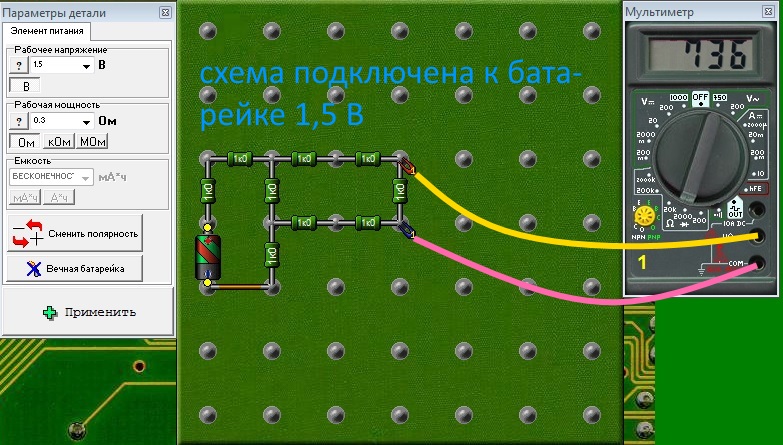
Resistance measurement with the circuit power off, but the measured resistor is not soldered out of the circuit. The device shows 833 ohms, not 1 kOhm. The reason is that the battery in the circuit is disconnected, but the resistors connected in parallel remain.
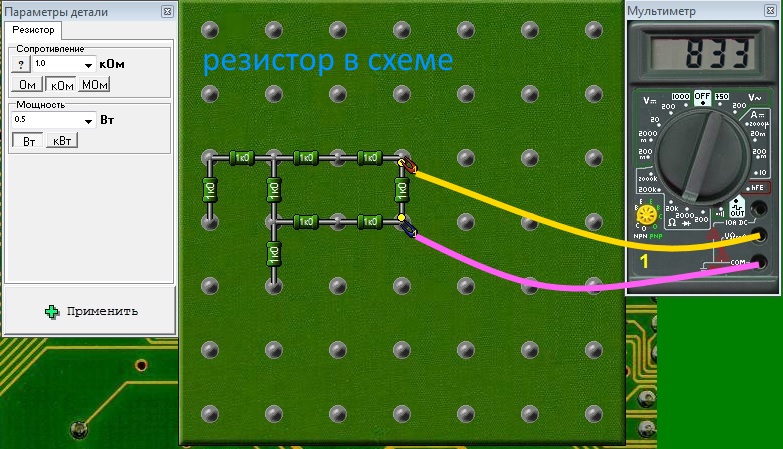
Resistance measurement with at least one output disconnected. This is the correct method for measuring resistance, on the device we see the true value of the resistance of the resistor being tested, 1000 ohms which is equal to 1k ohm. The ohmmeter current flows only through the measured resistance.
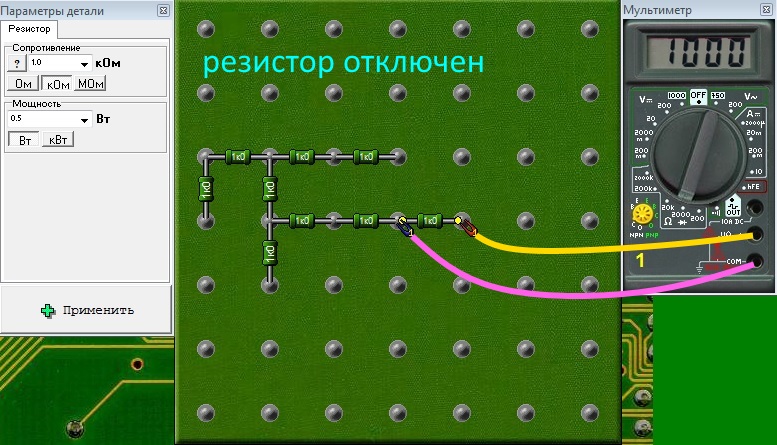
When using capacitor capacitance meters and inductance measuring instruments, the above rules must be observed.
The material of the article is duplicated on video:
Main characteristics electrical appliances– type of electric current, voltage and current. To connect it, you need to know what voltage is in the outlet, and what maximum current it is designed for. These parameters are indicated on the body of the outlet, most often on its body or front panel. In everyday life, an alternating single-phase or three-phase current is used, with a voltage of 220 or 380 volts, respectively.
And the answer to the question, what is the current strength in a 220V outlet depends on the cross section of the connected wires and the power of the electrical appliance. In order to determine the current strength, it is necessary to divide the power by the voltage - the resulting number will be the current strength, measured in amperes (A).
What is the current strength in the socket 220v and 380v?
For most household electrical appliances 220 volt outlets required. Previously, two wires (phase and zero) were used to connect them. Today, a three-wire connection scheme is used, where the third wire connects the appliance case to the ground loop. If during operation the insulation is broken and the case is energized, then when a person touches it, the device will automatically work protective shutdown(RCD) and the power supply will be cut off immediately.
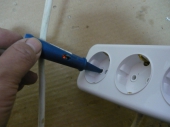

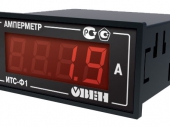
When choosing which outlet to install, it is necessary to take into account the power of the devices that are supposed to be connected to it. For example, a 25A 220V socket is designed for a power consumption of 5.5 kW, i.e. Able to withstand most household electrical appliances. To connect it, you need to use copper wire section 2.5 mm2. But, for most devices (computer, TV, vacuum cleaner), you can use less powerful 16A sockets. They are rated at 3.5 kW. But to connect electric stoves and ovens, you will need equipment designed for 32A 220V, with a power of up to 7 kW.
We measure the current strength and find the phases
However, to connect powerful household electrical appliances and power tools, as a rule, a 380-volt socket with a three-phase current is used. Application three-phase current allows you to reduce the cross section of the cable or wire, as well as more rational use of electricity. Some electric motors and equipment can only operate on three-phase current.
To determine how many volts are in the outlet, you can use measuring instruments with a voltmeter or tester, but this can also be determined by the shape of the electrical installation products. A single-phase plug socket has three pins (phase, zero and ground). The number of pins can be two or three, depending on the type of cable connection to the ground loop. A two-pin connection is used when the ground contact is located on the housing.
Unlike a single-phase socket, a 3-phase socket has 5 contacts: three phases, zero and ground. The number of pins also depends on the location of the grounding contact (a separate pin or on the socket body) and can have 4 or 5 pins. Typically, the design three-phase socket is made in such a way as to prevent the possibility of accidentally touching contacts that are larger than for connecting to single-phase network. The housing closes access to the contact group before the connection begins.
There is some difference in how to determine what current is in the socket for three-phase current. The calculation rule is almost the same as for a single-phase eye, only it must be taken into account that 220V is connected to each wire, therefore, when calculating the total power, the total voltage (220Vx3 \u003d 660V) must be multiplied by the current strength. This means that an electrical device with a power of 16.5 kW can be connected to a 25A 380V socket.
But sometimes it becomes necessary how to determine in which contact there is a phase. The easiest way to do this is with an indicator, in which a light bulb or LED lights up when you touch a live contact. Experienced craftsmen can determine this with a tester or test lamp. But this method is better to use if you have experience.
Submit a dwelling modern man without electrical sockets impossible. And so many people want to know more about the force that brings warmth and light to civilization, making all our electrical appliances work. And they start with the question: what current is in our outlet, direct or alternating? And which one is better? To answer the question, what is the current in the outlet and what is the reason for this choice, let's find out how they differ.
DC voltage sources
All experiments carried out by scientists with electric shock, started with him. The first, still primitive, sources of electricity, like modern batteries, were capable of delivering direct current.
Its main feature is the invariability of the current value at any time. Sources, in addition to galvanic cells, are special generators, batteries. A powerful source of direct voltage is atmospheric electricity - lightning discharges.
AC voltage sources
In contrast to the constant, the magnitude of the alternating voltage changes in time according to a sinusoidal law. For him, there is the concept of a period - the time during which one complete oscillation occurs, and frequency - a quantity inverse to the period.
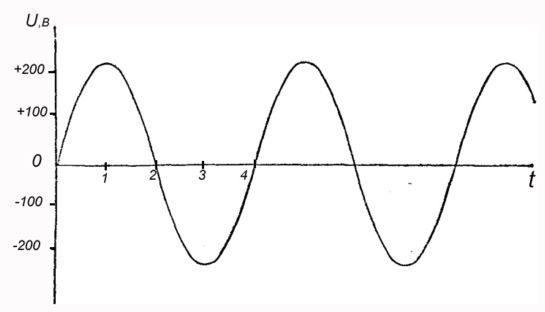
AT electrical networks Russia has adopted an alternating current frequency of 50 Hz. But in some countries this value is 60 Hz. This should be taken into account when purchasing household electrical appliances and industrial equipment, although most of it works fine in both cases. But it is better to make sure of this by reading the instruction manual.
AC Benefits
Our sockets carry alternating current. But why exactly is he, why is he better than permanent?
The fact is that only the magnitude of the alternating voltage can be changed using converter devices - transformers. And you have to do it multiple times.
Thermal power plants, hydroelectric power plants and nuclear power plants are located far from consumers. There is a need to transfer large capacities over distances of hundreds and thousands of kilometers. The wires of power lines have little resistance, but it is still present. Therefore, the current passing through them heats the conductors. Moreover, due to the potential difference at the beginning and end of the line, less voltage comes to the consumer than it was at the power plant.
You can fight this phenomenon by either reducing the resistance of the wires, or by reducing the current value. Reducing the resistance is possible only with an increase in the cross section of the wires, and this is expensive, and sometimes technically impossible.
But you can reduce the current by increasing the value of the line voltage. Then, when transmitting the same power, the current through the wires will be less. Reduce heating losses of wires.
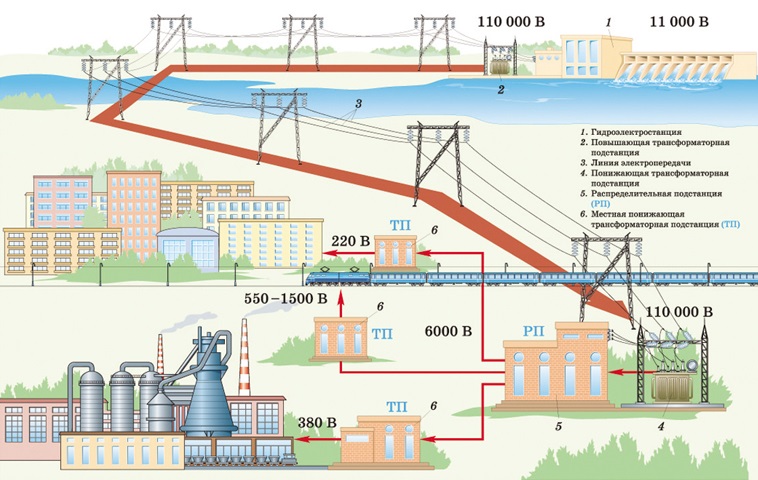
Technically it looks like this. From the alternators of the power plant, voltage is supplied to the step-up transformer. For example, 6/110 kV. Further along the power line with a voltage of 110 kV (abbreviated as power transmission line-110 kV) Electric Energy sent to the next distribution substation.
If this substation is intended to supply a group of villages in the area, then the voltage is reduced to 10 kV. If at the same time it is necessary to send a significant part of the received power to an energy-intensive consumer (for example, a combine or plant), 35 kV lines can be used. At nodal substations, three-winding transformers are used to divide the voltage between consumers located at different distances and consuming different powers. In our example, this is 110/35/6 kV.
Now the voltage received at the rural substation is undergoing a new transformation. Its value should be acceptable to the consumer. To do this, the power passes through a 10/0.4 kV transformer. The voltage between the phase and zero of the line going to the consumer becomes equal to 220 V. It reaches our sockets.
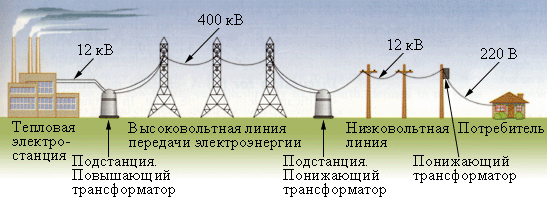
Do you think that's all? No. For semiconductor technology, which is the filling of our TVs, computers, music centers, this value will not work. Inside them, 220 V is reduced to an even lower value. and converted to direct current.
Here is such a metamorphosis: it is better to transmit alternating current over long distances, but we need, basically, direct current.
Another advantage of alternating current: it is easier to extinguish the electric arc that inevitably occurs between the breaking contacts of switching devices. The supply voltage changes and periodically passes through the zero position. At this point, the arc goes out on its own under certain conditions. For direct voltage, more serious protection against burning of contacts will be required. But at short circuits on direct current, damage to electrical equipment from the action of an electric arc is more serious and destructive than on alternating current.
Advantages of DC
Energy from AC voltage sources cannot be stored. It can be used to charge a battery, but it will only supply direct current. And what will happen if, for some reason, the generator at the power plant stops or the power line of the village breaks? Its residents will have to use battery-powered flashlights to avoid being left in the dark.
But power plants also have sources of constant voltage - powerful batteries. Indeed, in order to start the equipment that has stopped due to an accident, electricity is needed. For mechanisms, without which it is impossible to start the equipment of a power plant, electric motors are powered by direct voltage sources. And also - all protection, automation and control devices.
Also on constant voltage electrified transport works: trams, trolleybuses, metro. DC motors have more torque at low rotational speeds, which is necessary for the electric train to successfully start. And the very adjustment of the engine speed, and, consequently, the speed of the movement of the train, is easier to implement on direct current.





